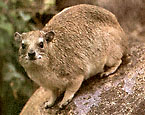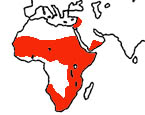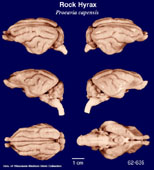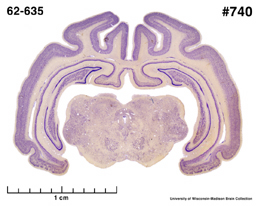|
Rock
Hyrax Procavia capensis
Head and body length of P. capensis is 305-550 mm. There
is no external tail. Males weigh an average of 4 kg while females
average about 3.6 kg. The pelage is made up of thick dense fur
with scattered guard hairs. Coloration is brownish gray, lighter
flanks and somewhat creamy coloration underneath. Individual
coloration can vary in intensity. The soles of the feet are
smooth, moist and rubberlike, allowing the Rock Hyrax traction
on smooth surfaces and steep slopes. Whiskers can reach a length
of 180mm. There is a gland on the back which is covered by a
patch of black hairs. During a display of aggression, the hairs
stand erect and the gland is exposed.
P. capensis is found in rocky and scrub-covered areas
which afford the animals places to dig burrows. The Rock Hyrax
also has poor thermoregulatory capabilities and avoids emerging
from its shelter if the temperatures are too hot or too cold.
Often, several individuals will congregate in a burrow to conserve
heat.
A vegetarian, P. capensis will eat any available plant
and is adept at climbing trees to eat the leaves of a far reaching
branch. It will drink water when available, but can get a good
deal of its needed moisture from the food it eats. Family group
sizes vary greatly, but generally consist of one dominant male,
possibly a subordinate male and several females. Males usually
leave the family group at 16-30 months, and may live alone for
some time. Colonies are made up of family groups and may contain
hundreds of animals. The members of the group all feed together
with one of the females or the dominant male keeping watch on
a high rock or branch. If the sentry senses danger, an alarm
call is given and the group immediately seeks cover.
Births occur at different times of year depending on the distribution
of P. capensis. Gestation is about 240-45 days. Females
have 6 mammae and litter size is 1-6, with the babies weighing
170-240 grams each. They are covered with fur and the eyes are
open at birth. They can move about capably at a day old and
start taking solid food at about 2 weeks. The offspring nurse
for about 1-5 months and sexual maturity is reached at 16-17
months. Life expectancy in the wild is about 8.5 years, though
one captive individual lived to age 11.
P. capensis is found in Sub-Saharana and NE Africa (a
line from Senegal through S Algeria and Libya, Egypt to southern
most tip of Africa), portion of the Levant (Syria, Lebanon,
Turkey, Israel), and the Arabian peninsula (Saudi Arabia, Yemen);
and the isolated mountains in Algeria and Libya.
|



